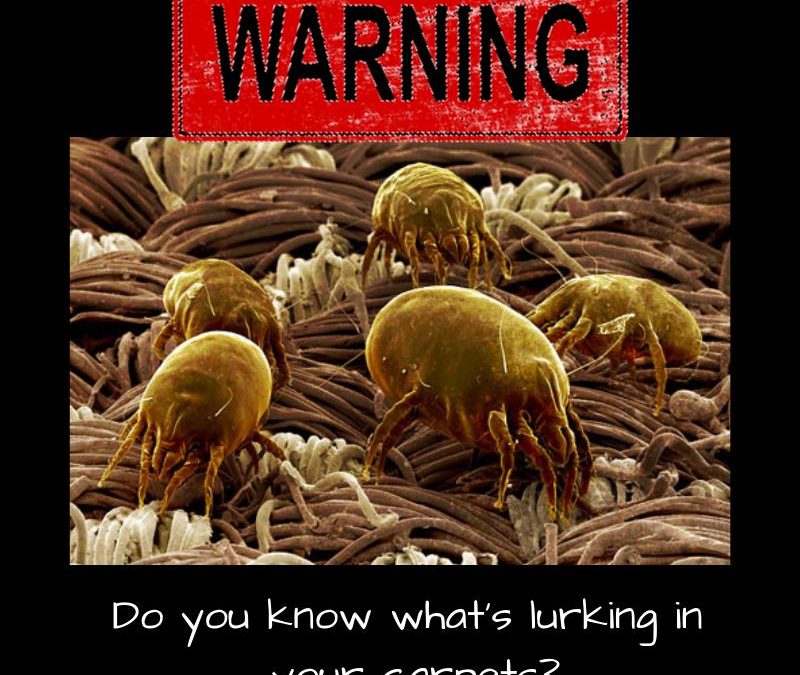The average house collects up to 40 pounds of dust in a year, and up to 2000 dust mites can live on only one ounce of carpet!
Dust mites like to eat dead skin from pets and humans and the average person can shed enough skin a day to feed a million dust mites. In the spring, dust mite problems can turn into infestations and not cleaning correctly can make it worse. The fall and winter months are particularly problematic because we close up our houses and the concentrations of dust mites and their feces increases inside.
Dust mites are not parasites; they don’t bite, sting or burrow into our bodies BUT the harmful allergen created by their fecal matter and body fragments leads to poor air quality in our homes. Our carpets act as filters in our homes and just like any other filter, it’s necessary to have a regular cleaning schedule.
Avoiding exposure to dust mites is the best strategy for controlling dust mite allergy. While you can’t completely eliminate dust mites from your home, you can significantly reduce their number. Here’s how:
Use allergen-proof bed covers
Keep your mattress and pillows in dust-proof or allergen-blocking covers. These covers, made of tightly woven fabric, prevent dust mites from colonizing or escaping from the mattress or pillows. Encase box springs in allergen-proof covers.
Wash bedding weekly
Wash all sheets, blankets, pillowcases, and bed covers in hot water that is at least 130 F (54.4 C) to kill dust mites and remove allergens. If bedding can’t be washed hot, put the items in the dryer for at least 15 minutes at a temperature above 130 F (54.4 C) to kill the mites. Then wash and dry the bedding to remove allergens. Freezing non-washable items for 24 hours also can kill dust mites, but this won’t remove the allergens.
Keep humidity low
Maintain relative humidity below 50 percent in your home. A dehumidifier or air conditioner can help keep humidity low, and a hygrometer (available at hardware stores) can measure humidity levels.
Choose your bedding wisely
Avoid bed covers that trap dust easily and are difficult to clean frequently.
Buy washable stuffed toys
Wash them often in hot water and dry thoroughly. Also, keep stuffed toys off beds.
Remove dust don’t just push it around
Use a damp or oiled mop or rag rather than dry materials, such as feather dusters, to clean up dust. This prevents dust from becoming airborne and resettling.
Vacuum regularly
Vacuuming carpeting and upholstered furniture will remove surface dust, but vacuuming isn’t effective at removing most dust mites and dust mite allergens. Use a vacuum cleaner with a double-layered microfilter bag or a high-efficiency particulate air (HEPA) filter to help decrease house-dust emissions from the cleaner. If your allergies are severe, stay out of the area being vacuumed while someone else does the work. Wait about two hours before going back in the vacuumed room.
Reduce clutter
If it collects dust, it also collects dust mites. Remove knickknacks, tabletop ornaments, books, magazines and newspapers from around the house, especially in your bedroom.
Install a high-efficiency media filter in your furnace and air conditioning unit
Look for a filter with a Minimum Efficiency Reporting Value (MERV) of 11 or 12 and leave the fan on to create a whole house air filter. Be sure to change the filter every three months.
Have your carpets professionally cleaned at least once per year
Hot Water Extraction carpet cleaning (a.k.a. Steam Cleaning) is recommended a minimum of once a year and even quarterly for those that suffer from allergies, asthma, or eczema. Click on the link to learn more about our exclusive 12-step cleaning process.

